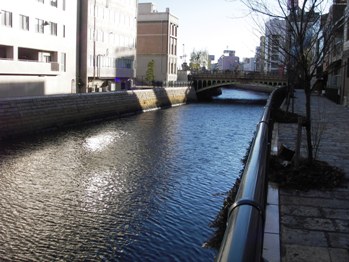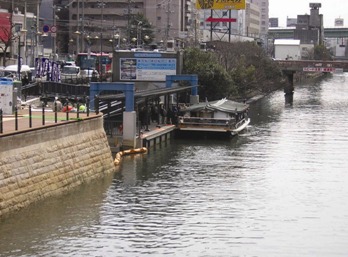|
Photo by Susumu Domon, Jan. 2006
|
|
Source: RIVER FRONT vol.54
|
Regarding Hori River flowing north to south through the center of Nagoya City, there were industrial areas consisting of many factories and warehouses along the river and urban areas full of commercial facilities and residences built with their backs to Hori River. Additionally, the water quality was very deteriorated, which led to diminishment of the vibrant atmosphere. In this situation, a movement to regenerate Hori River, or the mother river of Nagoya, flourished and the river was listed as a “My Town, My River Improvement Project (A Waterfront Plan project)” river in June 1988. Since then, the Hori River restoration project has been conducted by the Nagoya City government and the local citizens.
By JRRN-secre | Category: Community and urban river restoration,Chubu | Comment(0) | Trackback(0) |
Date: 2012.01.05 16:14
For Genbee River, citizens, companies and the government are working together on Genbee River Waterpark Project, by cleaning the environmental water and improving the recreational waterfront to recover the deteriorated waterfront environment. Citizens' groups clean the river periodically and release nymphs of fireflies into the river. As a result of these activities, a beautiful waterfront richly endowed with nature has been recovered.
Today, Genbee River is highly evaluated as a good case example in which a lost river has been recovered by citizens participating in urban development. It won the highest award of the "Civil Engineering Design Prize 2004, JSCE (Japan Society of Civil Engineers)" and “the Handmade Hometown Award" (local improvement section), City Landscape Award, "the Beautiful Town Award" in 2005 and the gold prize of "the Excellent Tourist Spot Creation Award” in 2006. Also it was designated as one of the 100 famous Heisei waters, 100 hometowns for nurturing water, greenery and culture and 100 best canals in Japan.
By JRRN-secre | Category: Community and urban river restoration,History and traditional restoration,Chubu | Comment(0) | Trackback(0) |
Date: 2011.09.10 18:33
At the mouth of Shonai River and Shin River, Fujimae mud flats spread, which is well known for visiting natatorial birds. Downstream of Shonai River, sand deposition is accelerated on the riverside, causing a floristic variation from reeds to miscanthus sacchariflorus and willow tree communities in the riverbed. At the same time, poor waterfront vegetation caused by decreasing flood frequency has become a problem in the areas used for agriculture and as a playground.
Under the circumstances, a project is being conducted to regenerate the waterfront vegetation such as the reed beds by excavating the riverbed to reduce the waterfront gradient and recover the frequency of floods in the riverbed following the heavy rain in Tokai in 2000.
By JRRN-secre | Category: Nature oriented restoration,Chubu | Comment(0) | Trackback(0) |
Date: 2011.09.10 18:07
In midstream Chikuma River in Nagano Prefecture, most of the banks and side bars were pebble riverbeds until the Meiji Period. These days, however, the vegetation grows thickly in many places while waterfront plants such as reeds and cattails are disappearing rapidly. This is because the channel has become static as the riverbed has lowered and the frequency of flooding reduced.
For this reason, a natural regeneration project research was started in 2002 to regenerate the diversified functions of the river. In Awasa district of Chikuma City, a trial excavation experiment is being conducted to study the shape of the channel to be excavated as well as the excavation method so that a river environment unique to Chikuma River may be regenerated.
By JRRN-secre | Category: Nature oriented restoration,Chubu | Comment(0) | Trackback(0) |
Date: 2011.09.10 18:06
Sana River running through the eastern Mikawa area of Aichi Prefecture became so contaminated that the BOD was 60 mg/l, which was measured at the environmental basing point located downstream in 1978. This was because of the urbanization in the peripheral area that occurred during the decade starting in 1965. However, the construction of the sewage system was started in Toyo River Basin including Sana River Basin in 1980 and since then the water quality has been largely improved along with the progress of the sewage system improvement.
Today, children playing with water can be seen and a project to change the dike into a flower corridor is being promoted by community residents. Also, this river has been selected as one of the "100 revived waters", thus it is being changed into a river cherished by the local people.
By JRRN-secre | Category: Water quality Restoration,Chubu | Comment(0) | Trackback(0) |
Date: 2010.09.10 18:22







